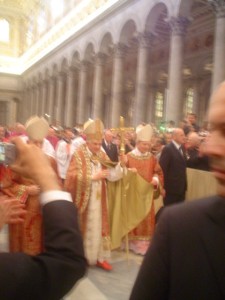Feast of St. Thomas
When I began attending the Extraordinary Form of the Latin Rite Mass, the first Gospel I heard proclaimed I heard “Didymus,” and something called at me quickly that this must be the story of Jesus appearing to “Doubting Thomas” after the Resurrection. Today we celebrated the feast of St. Thomas, the Apostle, who was Martyred in India by lances at the order of the King. This man who had put his hand into the wound on the side of Christ would experience the same piercings for love of Him who died for love of us.
Archbishop Sheen dedicates a few pages to St. Thomas in Life of Christ in which he shows that it is in Thomas’ gloominess that doubts are formed, but that his doubts and the reconciliation of doubts are good for humanity. Ten of St. Thomas’ most trusted companions tell him that the Lord is risen, and they have seen him, but as Archbishop Sheen puts it, “Sometimes a man who misses a meeting, misses much.” (p. 423) Thomas does not indicate he will not believe, but instead lays out the process by which he will believe, namely, “Except I shall see in his hands the print of the nails and put my finger into the place of the nails and put my hand into his side, I will not believe.”
The Lord appears to the Apostles a second time and without “the slightest trace of faultfinding, in Our Lord, as there would not be the slightest trace of faultfinding with Peter at a later appearance by the Sea of Galilee,” (p. 423) tells Thomas to “Put your finger here and see my hands,
and bring your hand and put it into my side, and do not be unbelieving, but believe.” At this, St. Thomas cries out, “Dominus meus et Deus meus!” “My Lord, and my God!”
“My Lord, and my God!” And at every Eucharistic feast as the priest raises into the air the sweet Host of Freedom, the Precious Body handed over for the Feast again, and again, our souls cry out from the depths of our hopes and desires this same hymn, “My Lord, and my God!”
It is because of St. Thomas, who saw and believed, that we few who are blessed because we did not see and believe, know the words to address our Brother and King. Archbishop Sheen puts it succinctly, “In one burning utterance, Thomas gathered up all of the doubts of a depressed humanity to have them healed by the full implications of the exclamation, ‘My Lord and my God!’ ” (p. 424)
Just days after we hear in Mass, “tu es Christus Filius Dei vivi” (You are the Christ, the Son of the Living God) and the blessing that Christ gives Simon: “beatus es Simon Bar Iona” (Blessed are you Simon Bar-Jona) and “Tu es Petrus et super hanc petram aedificabo ecclesiam meam et portae inferi non praevalebunt adversum eam” (You are Peter, and upon this rock I will build my church, and the Gates of Hell shall not prevail against it), we hear the full Revelation of the Life and Resurrection of the Christ from the lips of a man who is very much like we, always demanding a sign.
“O Glorious Saint Thomas, your grief for Jesus was such that it would not let you believe he had risen unless you actually saw him and touched his wounds. But your love for Jesus was equally great and it led you to give up your life for him. Pray for us that we may grieve for our sins which were the cause of Christ’s sufferings. Help us to spend ourselves in his service and so earn the title of “blessed” which Jesus applied to those who would believe in him without seeing him. Amen.” – http://saints.sqpn.com/pray0151.htm
Lord, we believe, but help us with our unbelief.

I really liked this post. It brings together today’s (?) Gospel reading and Archbishop Sheen’s two cents. Praise God for coming to us in the Eucharist!